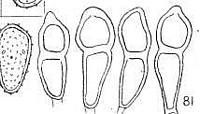|
 Puccinia anisotomes Puccinia anisotomes
BiostatusPresent in region - Indigenous. Endemic
Images (click to enlarge)
Caption: FIG. 81. Puccinia Anisotominis G.H. Cunn. on Anisotome Haastii (F. v. Nl.) Cockayne and
Laing. Teleutospores and uredospore. |
Article: Cunningham, G.H. (1924). The Uredinales, or rust-fungi, of New Zealand: supplement to Part 1; and Part 2. Transactions and Proceedings of the New Zealand Institute 55: 1-58 Wellington:.
Description: 0, I. Unknown.
II. Uredosori hypophyllous, crowded on discoloured spots, elliptical, 1-2 mm. long, bullate,
pallid ferruginous, long covered. Spores subglobose, elliptical or obovate, 24-40 X 18-22
mmm.; epispore hyaline, sparsely and somewhat coarsely echinulate, 1.5-2 mmm. thick, cell-contents granular, tinted brown; germ-pores 4,
equatorial, obscure.
III. Teleutosori amphigenous, chiefly hypophyllous, crowded in scattered groups, elliptical
when 1-1.5 mm. long, or confluent and attaining a length of 3 mm., bullate, pulverulent, dark
chestnut-brown, long covered, becoming exposed by the longitudinal fissuring of the
epidermis. Spores elongate-clavate, 40-60 X 17-22 mmm.; apex bluntly acuminate, seldom
rounded, thickened up to 6 mmm., base attenuate, basal cell slightly longer and narrower than
the upper; constricted at the septum; epispore smooth, golden-brown, 2-2.5 mmm. thick in
upper cell, 1.5-2 mmm. thick in lower, cell-contents granular; pedicel persistent, hyaline,
fragile, up to 40 X 7 mmm.; germ-pore of the upper cell apical, conspicuous, basal pore
immediately beneath the septum, obscure.
Notes: The host is endemic, and is confined to the South Island, where it is not uncommon in the
mountain districts. (Cheeseman, 1906, p. 217.) This rust is separated from the two preceding
species on account of the differently-shaped longer teleutospores (which have a smooth
epispore), and much larger coarsely-echinulate uredospores. The five species which have
been recorded on the genera Angelica and Anisotome show a general family resemblance to
one another, and may readily be separated by reference to the following table. The presence
or absence of an aecidium is not given below as a specific character, as the cycle of those
species in which it appears to be absent is at present too imperfectly known.
Article: Dingley, J.M. (1969). Records of plant diseases in New Zealand. New Zealand Department of Scientific and Industrial Research, Bulletin 192: 298 p. Wellington:.
Notes: Cunningham (1931a) stated that the host [Anisotome haastii] is endemic and
confined to mountain districts of the South Island. Puccinia anistominis is an
endemic species of rust occurring only on an endemic host plant.
|